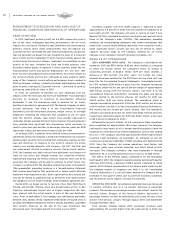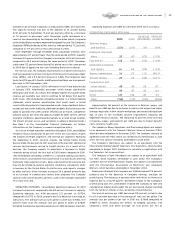Southwest Airlines 2001 Annual Report Download - page 20
Download and view the complete annual report
Please find page 20 of the 2001 Southwest Airlines annual report below. You can navigate through the pages in the report by either clicking on the pages listed below, or by using the keyword search tool below to find specific information within the annual report.
SOUTHWEST AIRLINES CO. 2001 ANNUAL REPORT
F12
NOTES TO CONSOLIDATED FINANCIAL STATEMENTS
December 31, 2001
1. SUMMARY OF SIGNIFICANT ACCOUNTING POLICIES
BASIS OF PRESENTATION Southwest Airlines Co. (Southwest) is a
major domestic airline that provides primarily shorthaul, high-frequency,
point-to-point, low-fare service. The consolidated financial statements
include the accounts of Southwest and its wholly owned subsidiaries
(the Company). All significant intercompany balances and transactions
have been eliminated. The preparation of financial statements in
conformity with accounting principles generally accepted in the United
States requires management to make estimates and assumptions that
affect the amounts reported in the financial statements and
accompanying notes. Actual results could differ from these estimates.
Certain prior year amounts have been restated to conform to the
current year presentation.
CASH AND CASH EQUIVALENTS Cash equivalents consist of
certificates of deposit and investment grade commercial paper issued
by major corporations and financial institutions. Cash and cash
equivalents are highly liquid and generally have original maturities of
three months or less. Cash and cash equivalents are carried at cost,
which approximates market value.
INVENTORIES Inventories of flight equipment expendable parts,
materials, and supplies are carried at average cost. These items are
generally charged to expense when issued for use.
PROPERTY AND EQUIPMENT Depreciation is provided by the
straight-line method to estimated residual values over periods ranging
from 20 to 25 years for flight equipment and 3 to 30 years for ground
property and equipment. See Note 2 for further information on aircraft
depreciation. Property under capital leases and related obligations are
recorded at an amount equal to the present value of future minimum
lease payments computed on the basis of the Company’s incremental
borrowing rate or, when known, the interest rate implicit in the lease.
Amortization of property under capital leases is on a straight-line
basis over the lease term and is included in depreciation expense. The
Company records impairment losses on long-lived assets used in
operations when events and circumstances indicate that the assets
might be impaired and the undiscounted cash flows to be generated by
those assets are less than the carrying amounts of those assets.
AIRCRAFT AND ENGINE MAINTENANCE The cost of scheduled
engine inspections and repairs and routine maintenance costs for
aircraft and engines are charged to maintenance expense as incurred.
Scheduled airframe inspections and repairs, known as “D” checks, are
generally performed every ten years. Costs related to “D” checks are
capitalized and amortized over the estimated period benefited,
presently the least of ten years, the time until the next “D” check, or
the remaining life of the aircraft. Modifications that significantly
enhance the operating performance or extend the useful lives of
aircraft or engines are capitalized and amortized over the remaining
life of the asset.
REVENUE RECOGNITION Tickets sold are initially deferred as “Air
traffic liability.” Passenger revenue is recognized when transportation
is provided. “Air traffic liability” primarily represents tickets sold for
future travel dates and estimated refunds, or exchanges, of tickets
sold for past travel dates. Estimated refunds and exchanges, including
the underlying assumptions, are evaluated each reporting period with
resulting adjustments included in “Passenger revenue.” Factors which
may affect estimated refunds include, but may not be limited to, the
Company’s refund policy, the mix of refundable and nonrefundable
fares, and fare sale activity. The Company’s estimation techniques
have been consistently applied from year to year; however, as with any
estimates, actual refund and exchange activity may vary from
estimated amounts. The Company believes it is unlikely that
materially different estimates would be reported under different
assumptions or conditions.
FREQUENT FLYER PROGRAM The Company accrues the estimated
incremental cost of providing free travel for awards earned under its
Rapid Rewards frequent flyer program. The Company also sells flight
segment credits and related services to companies participating in its
Rapid Rewards frequent flyer program. Prior to 2000, revenue from
the sale of flight segment credits was recognized when the credits
were sold. However, beginning January 1, 2000, funds received from
the sale of flight segment credits and associated with future travel are
deferred and recognized as “Passenger revenue” when the ultimate
free travel awards are flown or the credits expire unused. See Note 2.
ADVERTISING The Company expenses the costs of advertising as
incurred. Advertising expense for the years ended December 31, 2001,
2000, and 1999 was $147.6 million, $141.3 million, and $137.7 million,
respectively.
STOCK-BASED EMPLOYEE COMPENSATION Pursuant to Statement
of Financial Accounting Standards No. 123 (SFAS 123), “Accounting for
Stock-Based Compensation,” the Company accounts for stock-based
compensation plans utilizing the provisions of Accounting Principles
Board Opinion No. 25 (APB 25), “Accounting for Stock Issued to
Employees” and related Interpretations. See Note 12.
FINANCIAL DERIVATIVE INSTRUMENTS The Company utilizes a
variety of derivative instruments, including both crude oil and heating
oil based derivatives, to hedge a portion of its exposure to jet fuel price
increases. These instruments primarily consist of purchased call
options, collar structures, and fixed price swap agreements. Prior to
2001, the net cost paid for option premiums and gains and losses on all
financial derivative instruments, including those terminated or settled
early, were deferred and charged or credited to fuel expense in the
same month that the underlying jet fuel being hedged was used.
However, beginning January 1, 2001, the Company adopted Statement
of Financial Accounting Standards No. 133 (SFAS 133), “Accounting for
Derivative Instruments and Hedging Activities,” as amended, which
changed the way it accounts for financial derivative instruments. See
Note 2 and Note 9.
RECENT ACCOUNTING DEVELOPMENTS During 2001, the Financial
Accounting Standards Board (FASB) issued SFAS No. 143, “Accounting
for Asset Retirement Obligations,” which is effective for financial
statements issued for fiscal years beginning after June 15, 2002. The
pronouncement addresses the recognition and remeasurement of
obligations associated with the retirement of tangible long-lived
assets. On October 3, 2001, the FASB issued SFAS No. 144, “Accounting
for the Impairment or Disposal of Long-Lived Assets,” which is effective
for financial statements issued for fiscal years beginning after
December 15, 2001. SFAS No. 144 supersedes SFAS No. 121, “Accounting
for the Impairment of Long-Lived Assets and for Long-Lived Assets to Be
























